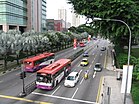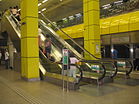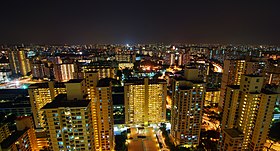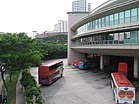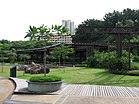Toa Payoh
This article includes a list of general references, but it lacks sufficient corresponding inline citations. (April 2015) |
Toa Payoh | |
|---|---|
| Other transcription(s) | |
| • Chinese | 大巴窑 (Simplified) 大巴窯 (Traditional) |
| • Hokkien | Tōa Pa-iô |
| • Pinyin | Dàbāyáo |
| • Malay | Toa Payoh |
| • Tamil | தோ பாயோ |
From top left to right: Toa Payoh Town Centre; Lorong 6 Toa Payoh; Toa Payoh MRT station; Toa Payoh at night with Bishan and Serangoon in the distance; Toa Payoh Bus Interchange; Toa Payoh Town Park | |
| Coordinates: 1°20′3.49″N 103°51′22.78″E / 1.3343028°N 103.8563278°E | |
| Country | |
| Region | Central Region
|
| CDC | |
| Town councils |
|
| Constituencies | |
| Government | |
| • Mayor | Central Singapore CDC
|
| • Members of Parliament | Bishan-Toa Payoh GRC
Potong Pasir SMC |
| Area | |
| • Total | 8.17 km2 (3.15 sq mi) |
| • Residential | 2.48 km2 (0.96 sq mi) |
| Population | |
| • Total | 120,650 |
| • Density | 15,000/km2 (38,000/sq mi) |
| Demonym | Official
|
| Postal districts | 11, 12, 13 |
| Dwelling units | 36,439 |
| Projected ultimate | 61,000 |
Toa Payoh is a planning area and matured residential town located in the northern part of the Central Region of Singapore.[4][5] Toa Payoh planning area borders Bishan and Serangoon to the north, the Central Water Catchment to the northwest, Kallang to the south, Geylang to the southeast, Novena to the west and Hougang to the east. Toa Payoh New Town is situated in the eastern portion of the Toa Payoh planning area. The latter occupies a much larger area, encompassing estates such as Potong Pasir and Bidadari.
Etymology
Toa Payoh, in Hokkien, translates as "big swamp" (with "Toa" meaning "big" and "Payoh" meaning "swamp"). The Malay word for swamp is paya. It is the Chinese equivalent of Paya Lebar, which translates to, big swamp land.
Toa Payoh's old Chinese name, was known as Ang Chiang San (alternatively An Xiang Shan) or "Burial Hill". The area was called as such because of the presence of an old cemetery located in the area.
John Turnbull Thomson, a government surveyor, refers to Toa Payoh in his 1849 agricultural report as Toah Pyoh Lye and Toah Pyoh.
Unique to the rest to the housing estates in Singapore, roads in Toa Payoh are given Malay street suffixes, (i.e.: "Jalan Toa Payoh", "Lorong Satu Toa Payoh") as when the town was conceived, Singapore was a state of Malaysia at that time.[6]
Toa Payoh is the second satellite town after Queenstown that was built by the Housing and Development Board (HDB). The plan to develop Toa Payoh was part of a $230 million building programme announced by then Deputy Prime Minister and Acting National Development Minister Toh Chin Chye in August 1960.However, due to difficulties in relocating the kampong (Malay for “village”) dwellers in the area, actual construction work only began in December 1964.
Tenders for the first building contract of 840 one-room housing units in Toa Payoh were called in November 1964. In total, Toa Payoh was envisaged to have 35,000 units to house some 250,000 people.Forty percent of the flats would be built as one-room rental flats, with the rest as three- or four-room flats. There were also plans to have about 480 shops, over 20 schools, and other amenities such as markets, clinics, cinemas, community centres, hawker centres and places of worship in Toa Payoh. These amenities, together with the housing units, were laid out based on the “neighbourhood concept”. This concept divided Toa Payoh into several neighbourhoods before grouping them around a town centre that acted as a focal point for the entertainment and shopping needs of residents. Toa Payoh, therefore, became a self-contained satellite town in which residents would have easy access to the things they needed. Toa Payoh was intended as a model for subsequent satellite towns built such as Ang Mo Kio and Telok Blangah.
After serving as the games village of the 7th South East Asian Peninsular (SEAP) Games in September 1973, Toa Payoh gained not only a sports complex and a swimming complex but also a public library when the four-story building used to house the SEAP Games Secretariat was converted into a library.Over the years, more facilities were added within the vicinity of Toa Payoh town centre such as a bus interchange, a Mass Rapid Transit (MRT) station, a park as well as community centres.
Infrastructure


The layout of the new town follows urban planning principles of the time. The housing estate is self-contained and has a town centre acting as a focal point for the shopping and entertainment needs of the residents.
Industrial developments were also built within the town to provide residents with job opportunities close to home while schools were built within the neighbourhoods.
Toa Payoh Central
The town centre was the first prototype in Singapore. It is surrounded by separated neighbourhoods, each with its own shopping amenities and community centres, well served by a network of vehicular roads and generous open space separating them. The result, as in the English new towns of the 1950s, is that residents tend less to travel to the main town centre but rather to shop within their neighbourhood; if they travel, they would go to the city via the MRT system, at the Toa Payoh and Braddell MRT stations, or public bus services at Toa Payoh Bus Interchange.
Nevertheless, with time, the Toa Payoh Town Centre has become increasingly popular. It has a busy atmosphere because, as with many shopping malls of the time, all commercial activities are concentrated along a single mall with high point blocks on either side and major department stores at each end. The shopping mall is actually L-shaped and there are two plazas, one with a branch library and cinema, the other with an area office and a post office. Each plaza has a department store at either end.
The commercial development, HDB Hub, located at the Toa Payoh Town Centre was completed in 2002. The Housing and Development Board relocated its headquarters from its premises at Bukit Merah to the HDB Hub on 10 June 2002. The HDB Hub comprises two wings, an atrium, four commercial building blocks, a leisure and learning centre and a three-storey basement parking lot. The building also accommodates Singapore's first fully air-conditioned Toa Payoh Bus Interchange and integrates it with the existing Toa Payoh MRT station.
Another landmark of Toa Payoh is the facility of Royal Philips Electronics (the Dutch multinational making medical and electronics equipment). Philips established an extensive facility, parts of which are now owned by Jabil and NXP. The facility has been used by Philips for developing, amongst others, televisions and DVD players for years.
There are only 3 condominiums in Toa Payoh, while the rest are public housings / apartments. The condominiums are Trellis, Trevista and Oleander Towers.
There is an interesting landmark in Toa Payoh Central, it is a small tree shrine known as Ci Ern Ge Temple. This shrine goes back to the kampong days before the town is setup. It is currently managed by Toa Payoh Central Merchants’ Association (TPCMA).[7] [8]
Toa Payoh Town Park

The Housing and Development Board decided to allocate a large area of Toa Payoh for a garden-landscaped park, the Toa Payoh Town Garden, despite the pressure on land here for housing.
The town garden used to be popular with visitors who came from near and far to enjoy the display of willows, bamboos and the brilliant reds and yellows of the Delonix regia trees. At the heart of the garden is a 0.8 ha carp pond which contains a waterfall and a cluster of islands linked by bridges. The islands are arranged to provide a sequence of delightful walking experiences not only by day but also by night when the garden is lit. The garden is buffered from the noise and night-time glare of passing traffic along Jalan Toa Payoh by an elevated slope planted with thick rows of Angsanas. There are also a children's playground, seating areas and outdoor chessboard, a tea kiosk and a 27-metre high viewing tower.
Toa Payoh Town Park was partially closed in 1999 to make way for a temporary bus interchange. After the new Toa Payoh Bus Interchange at the HDB Hub was completed in June 2002, the temporary bus interchange was converted to a landscaped park. Toa Payoh Town Garden was subsequently renamed as Toa Payoh Town Park.
Sports and recreation
The sporting facilities are based in the southern central part of Toa Payoh, which is located near the town centre. It consists of 3500 seater Toa Payoh Stadium, where S.League club Balestier Khalsa FC plays its home games. Toa Payoh Sports Hall is located besides the stadium, as well as the Singapore Table Tennis Association Academy. Meanwhile, there is also Toa Payoh Swimming Complex, where national swimmers train at the complex.
Besides these facilities located in the centre of the town, there are also street football courts, gym facilities and basketball courts available at various neighbourhoods of Toa Payoh. Meanwhile, SAFRA clubhouse is located besides Toa Payoh Stadium.


Politics
Toa Payoh is entirely located within the Bishan-Toa Payoh Group Representation Constituency, while a portion of Lorong 8 Toa Payoh was in the Potong Pasir Single Member Constituency prior to 2020. The section which is part of Bishan-Toa Payoh GRC is divided into three divisions, mainly Toa Payoh Central, Toa Payoh East and Toa Payoh West-Thomson. The members of parliament are Defence Minister Ng Eng Hen, Saktiandi Supaat and Chee Hong Tat of the People's Action Party, the ruling party of Singapore.
Education
The schools that are located within Toa Payoh include:
- Primary schools
- CHIJ Primary School (Toa Payoh)
- First Toa Payoh Primary School
- Kheng Cheng School
- Marymount Convent School
- Pei Chun Public School
- Secondary schools
- Beatty Secondary School
- CHIJ Secondary School (Toa Payoh)
- Raffles Girls School (RGS)
Popular Culture
TV shows
Books
- Toa Payoh: Our Kind Of Neighbourhood by Koh, Buck Song, a coffeetable corporate history of the Housing and Development Board and of 40 years of public housing, told through the stories of five families in Toa Payoh. Times Editions, Singapore, 2000. ISBN 981-232-124-1.
Poems
- "A Brief History of Toa Payoh" by Koh, Buck Song, published in the verse anthology "A Brief History of Toa Payoh And Other Poems", Imperial Publishing House, Singapore, 1992, and on the website of Bishan-Toa Payoh Town Council at http://www.btptc.org.sg/About%20Us/Poem.html
- "Toa Payoh Reborn" by Koh, Buck Song, in the Cultural Medallion project coffee table book Heartlands: Home And Nation In The Art Of Ong Kim Seng, Singapore 2008.
References
- ^ a b City Population - statistics, maps and charts | Toh Payoh
- ^ a b HDB Key Statistics FY 2014/2015 Archived 4 March 2016 at the Wayback Machine
- ^ "Statistics Singapore - Geographic Distribution - 2018 Latest Data". Retrieved 11 February 2019.
- ^ "Map of Planning Areas/Subzones in Singapore" (PDF). Singapore Department of Statistics. Archived from the original (PDF) on 5 March 2016. Retrieved 20 February 2016.
- ^ Singapore Infopedia | Toa Payoh New Town
- ^ [1]
- ^ "Ci Ern Ge (慈恩阁)". Retrieved 11 June 2020.
- ^ "Everyday Life of Chinese Singaporeans: Past & Present - Temple Visit Essay (Ci Ern Ge)" (PDF). Retrieved 11 June 2020.
- Victor R Savage, Brenda S A Yeoh (2003), Toponymics – A Study of Singapore Street Names, Eastern Universities Press, ISBN 981-210-205-1
- Norman Edwards, Peter Keys (1996), Singapore – A Guide to Buildings, Streets, Places, Times Books International, ISBN 9971-65-231-5
External links
- Toa Payoh Free Online Community Forums (Toa Payoh.NET)


